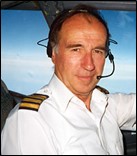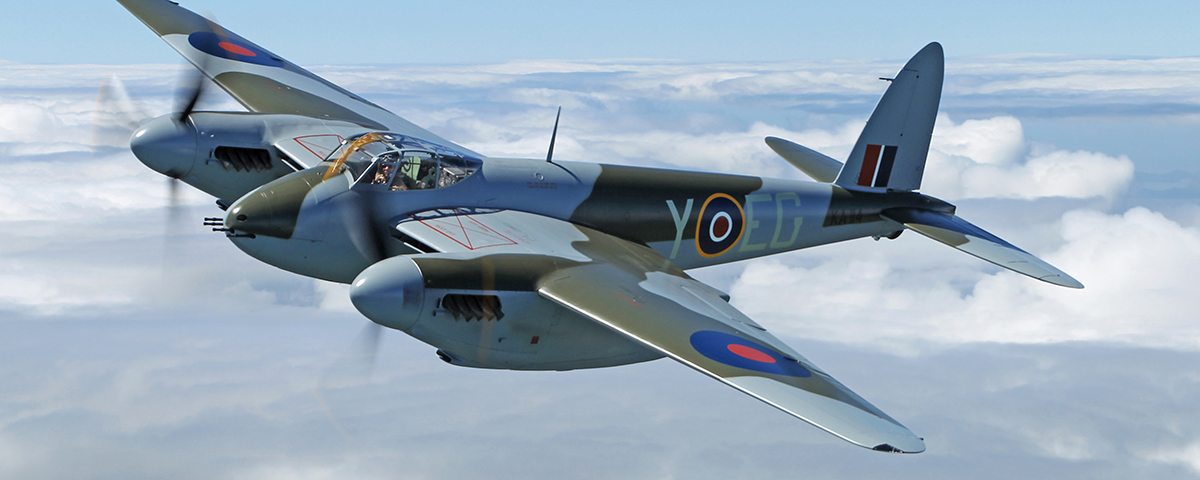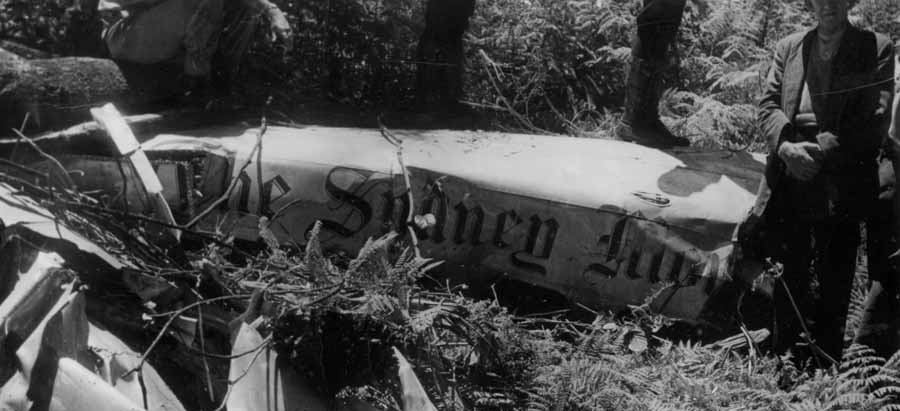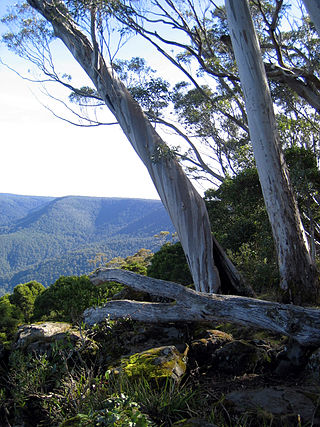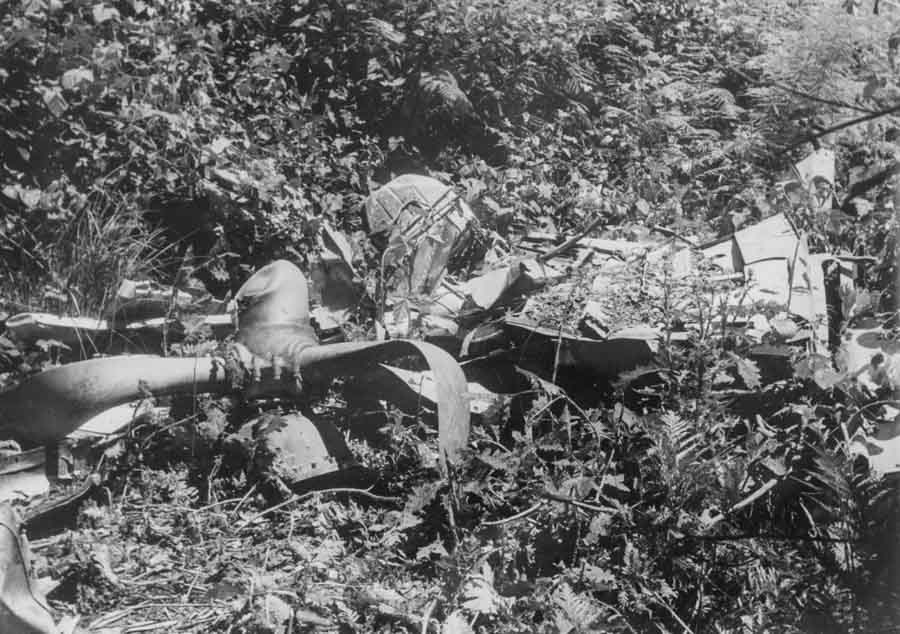
|
Vol 79 |
Page 14 |
|
Privacy Policy | Editorial Policy | Profit Policy | Join the Association | List of Members | Contact us | Index | Links |
|
Back Go to page: 1 2 3 4 5 6 7 8 9 10 11 12 13 14 15 16 17 18 19 20 Forward |
|
John Laming
Aircraft and other stuff. |
|
Contents.
Like overtaking on a blind corner.
|
|
Like overtaking on a blind corner and hoping nothing is coming the other...
In 1941, during World War Two, as a nine-year old, I was living in England with my 55-year old Uncle Alf and his wife Annie. Alf was a member of the Royal Observer Corps and I helped him spot and report on German enemy aircraft flying over our village. He was a keen carpenter and made me a wooden model of the Mosquito which had just entered service as a fighter-bomber with the RAF.
|
|
|
|
Alf had carved the model out of solid wood using photos and drawings handed out to the Observer Corps outposts because of its likeness to the familiar German Junkers 88 bomber. Alf told me to keep my model under wraps because, at that stage, they were told it was a secret bomber. Of course, I was terribly impressed.
In 1948, one year after migrating to Sydney in Australia, I was 16 and living in Camden, working as a general hand with the Herald Flying Services (HFS). It had a couple of freighter DC-3s and Hudsons. The manager of the HFS was former Wing Commander Harry Purvis AFC. The chief pilot (called Flight Superintendent in those days) was Doug Swain DFC. Doug won his DFC flying Mosquitos over Occupied Europe during WWII. Harry was also an engineer by trade and had been the chief engineer of the Australian pioneer pilot Sir Charles Kingsford Smith. During the war Harry Purvis was the RAAF chief Lockheed Hudson instructor. He took the surrender of several thousand Japanese troops at Surabaya in 1945. His was an amazing story.
I did my very first flight in an aeroplane of the Herald Flying Services. It was Hudson VH-SMK at Camden, NSW, in 1948 on a test flight following an engine change. The pilot was Harry Purvis. There were no seats since it was a freighter. I sat on the bare metal floor along with several other employees. There were no seat belts either. These Hudsons and DC-3s were used for the airborne dropping of newspapers to Northern and Central NSW.
In 1953, there was an England to Australia Air Race. Another former Mosquito pilot was Aubrey Oates who won a DFC flying against the Japanese. Oates ran a pub at Campbelltown near Camden. Known as “Titus” Oates after the story in 1705 of an English crook, Aubrey Oates was loaned a RAAF Mosquito from storage by the federal government to take part in the air race.
Doug Swain acted as the navigator. During the positioning flight to England prior to competing in the air race, the aircraft ran into monsoon weather over the Indian Ocean and ditched off the coast of Burma. Both crew survived, but that was the end of their air race attempt.
I visited Doug Swain (right) a few months later, where he was now a clerk in the head office of The Sydney Morning Herald at Hunter Street in Sydney. He was by then 37 and the Herald Flying Services had closed down a few years earlier. He was unhappy working in an office and not flying. I was in the RAAF at the time and in uniform when I dropped in to see Doug, who was one of my idols when I was at the HFS. I look back now and realise how he must have felt to see a youngster like me wearing RAAF wings and telling him about flying Mustangs and Vampires when he was in a dingy little office shuffling paperwork – when only ten years earlier he had risked his life over Europe. It was insensitive of me at the time, but I was so proud of myself and I thought Doug would be happy for me too. After all, I had been just a floor sweeper at the Herald Flying Services when he was chief pilot. The ball was now on the other foot I suppose.
At the time I visited Doug in early 1954, he told me he had succeeded in convincing SMH management to restart the Herald Flying Services. He also related the story of the Mosquito ditching in which he was involved. He said that Aubrey Oates, who was the pilot in command, was a loud-mouth type and both had strongly disagreed with each other on the course of action that they should take when they were lost in weather with lack of navaids and getting low on fuel.
That was the last time I saw Doug Swain until reading the newspapers a few weeks later of his disappearance in the Hudson he was flying. It was the inaugural flight of the new service and the commercial pressure to make a success of that first flight must have been on his mind. In the event, it was later found he had been scud running though the hills of the Barrington Tops range near Dungog, NSW, en route Sydney to Taree. The terrain was dangerous and covered in mist and rain. At the time the aircraft had not received DCA licence approval for IFR flight.
|
|
|
|
The Hudson wasn’t located until 15 months later. By coincidence, the aircraft that first spotted what turned out to be the missing Hudson was flown by another former pilot of the Herald Flying Services when I was there in 1948. His name was Bill Jenkins. I liked Bill very much as he was always kind to me. Bill eventually became a Qantas captain.
Many years ago, I was contacted by Richard Swain, a son of Doug Swain. He was just four years old when his father was killed in the Hudson crash. I think he must have seen one my stories published in an Australian aviation magazine. I gave him some photos I had of his father as well as my recollections of him. From my reading of the original accident report, combined with what I knew about Doug Swain’s flying and the risks involved with getting the newspapers to their destination almost regardless of weather, I recall trying to explain to Richard Swain (he was in his 50s by then) how that sort of accident could occur. Commercial pressures would have been strong to get the newspapers to their destination on time. So many pilots have lost their lives for similar reasons.
Recently I came across the following story by Richard Swain about his quest to locate the crash site of his father’s Hudson. He quoted a conversation I had with him when trying to explain the circumstances of his father’s crash. I must have said that scud running in low cloud and poor visibility was analogous to overtaking on a blind corner and hoping nothing is coming the other way. On reflection that is not a bad description.
This is what Richard Swain wrote:
Ghost of the past finally laid to rest.
It has taken him more than 50 years of looking, wondering and waiting, but on a remote ridge high on the Barrington Tops in New South Wales, Australia, Richard Swain has finally come to terms with the life and death of the father he never knew. It was 15 September, 2007, when he and his sister Suzanne Rose unveiled a commemorative plaque on the hillside where their father, Douglas, died in an aircraft crash.
“I know it’s an overworked word… this is some sort of closure, though,” Mr. Swain says.
Richard was four and his mother was pregnant with Suzanne when Captain Swain, his co-pilot and a passenger went missing on the afternoon of September 14, 1954. They were on a regular “milk run” from Mascot in a Lockheed Hudson, owned by the Herald, delivering newspapers to Taree, Kempsey, Armidale, Glen Innes, Inverell and Bingarra. An intensive land and air search of rugged bush country north of Dungog failed to find the plane, call-sign VH-SML. It was not until 15 months later that the crew of a Butler Airways Heron flying over the Barrington Tops spotted something, presumed metallic, glistening below in the bright sunlight.
Within 24 hours a police party, guided by the pilot in a Tiger Moth, found the wreck at about 900 metres on the Mountaineer Range, near Wangat, 40 kilometres from Dungog. By chance, the pilot of the Tiger Moth was Aubrey Oates who had ditched with Doug Swain in their Mosquito in the Burma Sea in 1953. The bodies of the three men – Swain, of Dee Why, Alistair Cole-Milne, of Neutral Bay, and David Burns, of Hawthorn, Victoria – were removed; inquests, funerals, air crash inquiries held.
Of the crash, Richard Swain, his brother and sisters were told nothing. “I don’t remember precisely when we found out,” he says. Of his father, who was 37, he has no recollection. “My personal memories of him, his face, are from photographs.” Though he had appeared in the newspapers at the time, bravely celebrating his fifth birthday as the search for his father wound down, he was quickly packed off to a Baulkham Hills boarding school. “We didn’t even go to the funeral. It was a generation thing, I suppose. We lived in an age when … such matters were quickly pushed out of the way and everyone moved on.”
Decades passed. The crash site was reclaimed by the bush. His mother remarried. A sister emigrated. A brother died in a motorcycle accident. Mr. Swain, now 57, ran away to sea, joined the merchant navy, ran a pilotage company. But he never forgot his father. Or his fatal accident.
“I always wanted to know more. I would start then get distracted.”
Five years ago, following a stroke, he suddenly found time on his hands. He began studying official reports, combing newspaper cuttings, talking to his late father’s friends, trying to relocate the crash site, to recover a life lost. He learnt that the aircraft had crashed in heavy rain, obscured by mist. A friend, John Laming, says VH-SML’s last movements were probably comparable to “overtaking on a blind corner and hoping no one’s there”. Commercial pressures to deliver newspapers on time – a risky venture involving low-flying “drops” through a hatch in the fuselage, or rapid ground handovers – were intense. Three other fleet aircraft had previously crashed.
The inquiry hinted at paperwork anomalies, technical troubles. Whatever the reasons, the aircraft “ploughed into the mountain from the south, cutting a swathe nearly 50 feet [15 metres] wide through heavy timber”. “Wreckage was strewn over 100 yards [90 metres]. About 20 trees, some of them up to two feet in girth had been sliced cleanly through.”
Some time ago, Mr. Swain drove to the Barrington Tops in search of the site. With the help of a Park’s Ranger, Peter Beard, local experts and forestry workers, they eventually found it in dense forest. “We went for a bit of a trek, poked around, disappeared in the scrub. Came back out. Had another go. It was hard going, but, suddenly – bang – there it was. Unbelievable.
“Bits of the whole plane are still there. You can feel its oil sticky on your hands.”
And what of Captain Swain? His son’s research reveals a brave, handsome man, a turner and fitter who went to England, flew Mosquitoes and Anson reconnaissance planes in World War II, and was awarded the Distinguished Flying Cross. Mike Bayon, who was Swain’s navigator during the war, wrote from England that he was “heroic, generous, quick to laughter, quick to anger … but never mean or vindictive”.
Mr. Swain and his sister say there are still gaps in the short life of their father. “I just wish my mother could have sat down and gone through it all with me,” he says. On return to Australia after the end of World War Two , Swain became manager and chief pilot of the Herald Flying Services fleet of Lockheed Hudsons and Dakota DC-3s.
“After all these years it was so important for me to know it was a job well done.”
Mission accomplished.
|
|
|
|
|
|
‘It’s not a tin shed’: New airport rises from western Sydney’s paddocks.
Western Sydney Airport is in talks with as many as 60 airlines interested in flying to the new hub after it opens in late 2026 as construction is ramped up on a large terminal to serve domestic and international passengers. Despite wet weather and the pandemic disrupting the $5.3 billion project, Western Sydney Airport chief executive Simon Hickey said construction of the airport remained “on time and on budget”.
|
|
Click the pic above to see a video of the construction.
A massive roof will be installed for the airport’s terminal early in the new year, while the first of multiple pours of concrete for the 3.7-kilometre (12,000ft) runway is due to start before Christmas. Residents near the curfew-free airport are due to be consulted on draft flight paths for aircraft in the middle of next year.
Positioning it as a “growth airport”, management wants to tap into western Sydney’s fast-growing and diverse population, rather than compete aggressively for passengers with Sydney Airport, which is about eight kilometres from the CBD. There’ll be a very strong international feel to this airport on opening. They are talking to about 60 airlines internationally at the moment about coming here..
There’ll be very strong demand for a strong Asia-Pacific network.
Sydney’s new airport will be able to handle 10 million passengers a year when it opens in late 2026, making it a similar size to Adelaide Airport. Built on a 1780-hectare site about 50 kilometres from Sydney’s CBD, the airport has been designed to grow to 82 million passengers annually by the 2060s.
The airport would use the latest technology to slash queuing times for passengers and turn around planes for flights quickly. Creating space and natural light was a key focus of the terminal’s design, in a move intended to reduce passenger stress. The Multiplex-built terminal will feature a computer-driven baggage system used by a number of the world’s top airports, instead of a conveyor belt method in use at other Australian airports. The new system will use digital technology to track, load and shift bags to and from planes. Passengers will be able to track their bags using an app and know when they will turn up on a baggage carousel after getting off a flight. Passengers are going to have greater surety that their bag is where it should be and that nothing has happened to it.
They call baggage systems the lungs of the airport because once you’ve got them in it’s very difficult to move structures to change that bag system. A veteran of the airline and construction industries believes the airport will change western Sydney in the same way the Harbour Bridge did the city 90 years ago. Most of western Sydney travels more than an hour every day to get to work. This will change that dynamic.
The terminal and runway are due to be completed by 2025, giving a year to bed down operations before the first passengers pass through the airport’s gates. |
|
|
|
|
|
|
|
Back Go to page: 1 2 3 4 5 6 7 8 9 10 11 12 13 14 15 16 17 18 19 20 Forward |
